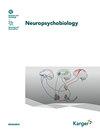Evaluating Oxidative Stress Markers in At-Risk Individuals for Bipolar Disorder: A Systematic Review and Meta-Analysis.
IF 3.1
4区 心理学
Q3 NEUROSCIENCES
引用次数: 0
Abstract
INTRODUCTION Bipolar disorder (BD), a mood disorder with recurrent affective episodes and a strong genetic basis is frequently associated with significant comorbidities, both physical and psychiatric, yet its neurobiology remains unclear. Recent evidence underscores oxidative stress as a pivotal factor linking BD to its comorbidities, prompting an investigation into whether this is a sign of a genetic vulnerability or a consequence of the disease. In this study, we systematically reviewed oxidative stress studies conducted on individuals at risk for BD. We performed a meta-analysis on studies examining oxidative DNA damage in these individuals. METHODS The literature was searched across the databases PubMed, Web of Science, Scopus, Ovid MEDLINE, and Cochrane to locate studies of oxidative stress markers in relatives of patients with BD compared with healthy controls (from 1946 to March 2024). Studies were considered for inclusion based on the following criteria: (i) involvement of first- or second-degree relatives of individuals diagnosed with BD, (ii) presence of a healthy control group, (iii) reporting of oxidative stress parameters for relatives, including mean and standard deviation or median and interquartile range (25-75%) values, and (iv) publication in the English language. Studies comparing the levels of 8-hydroxy-2'-deoxyguanosine (8-OH-dG) or its tautomer 8-oxo-7,8-dihydro-2'-deoxyguanosine (8-oxo-dG) in individuals at risk for BD with healthy controls were evaluated using a meta-analysis with the random-effects method. The risk of bias was evaluated using the Risk of Bias in Non-Randomized Studies of Exposure (ROBINS-E) tool. RESULTS Eleven studies were included in the systematic review and four studies for the meta-analysis. The meta-analysis included 543 individuals (first-degree relatives of individuals with BD = 238, control = 305). 8-OH-dG levels were found to be increased in first-degree relatives of individuals with BD compared to healthy controls (random effects: Hedges's g = 0.53, 95% CI = 0.36-0.71, p < 0.001). Findings of oxidative stress markers other than oxidative DNA damage in relatives of individuals with BD are limited and scarce. CONCLUSION In this meta-analysis, which consists of a limited number of studies, oxidative DNA damage seems to be a trait marker for BD. This finding could be associated with increased comorbidity and a higher risk of premature aging in individuals at risk for BD. However, further studies with larger sample sizes and longitudinal designs are warranted to confirm findings. Clarifying the changes in these markers from individuals at risk for the disorder throughout the course of the illness would help bridge the gap in understanding the role of oxidative pathways in the risk of BD.评估双相情感障碍高危人群的氧化应激标记物:系统回顾与元分析》。
简介躁郁症(BD)是一种反复发作的情绪障碍,具有很强的遗传基础,常伴有严重的躯体和精神并发症,但其神经生物学特性仍不清楚。最近的证据表明,氧化应激是将 BD 与其并发症联系起来的关键因素,这促使人们研究氧化应激是遗传易感性的表现还是疾病的后果。在本研究中,我们系统地回顾了针对BD高危人群进行的氧化应激研究。方法在 PubMed、Web of Science、Scopus、Ovid MEDLINE 和 Cochrane 等数据库中检索文献,查找有关 BD 患者亲属与健康对照组相比(1946 年至 2024 年 3 月)的氧化应激标记物的研究。纳入研究的标准如下:(i) 涉及确诊为 BD 患者的一级或二级亲属;(ii) 有健康对照组;(iii) 报告亲属的氧化应激参数,包括平均值和标准差或中位数和四分位间范围 (25-75%) 值;(iv) 以英语发表。采用随机效应法荟萃分析评估了比较 BD 高危人群与健康对照人群中 8-羟基-2'-脱氧鸟苷(8-OH-dG)或其同系物 8-氧代-7,8-二氢-2'-脱氧鸟苷(8-oxo-dG)水平的研究。结果系统综述纳入了 7 项研究,荟萃分析纳入了 4 项研究。荟萃分析包括 543 人(BD 患者的一级亲属 = 238 人,对照组 = 305 人)。研究发现,与健康对照组相比,BD 患者一级亲属的 8-OH-dG 水平升高(随机效应:Hedges's g = 0.53,95% CI = 0.36-0.71,p <0.001)。除氧化性 DNA 损伤外,有关 BD 患者亲属中氧化应激标记物的研究结果有限,且数量稀少。这一发现可能与 BD 高危人群的合并症增加和早衰风险增高有关。不过,还需要进行样本量更大和纵向设计的进一步研究,以证实研究结果。明确高危人群在整个患病过程中这些标记物的变化将有助于弥补在理解氧化途径在 BD 风险中的作用方面的差距。
本文章由计算机程序翻译,如有差异,请以英文原文为准。
求助全文
约1分钟内获得全文
求助全文
来源期刊

Neuropsychobiology
医学-精神病学
CiteScore
7.20
自引率
0.00%
发文量
26
审稿时长
6 months
期刊介绍:
The biological approach to mental disorders continues to yield innovative findings of clinical importance, particularly if methodologies are combined. This journal collects high quality empirical studies from various experimental and clinical approaches in the fields of Biological Psychiatry, Biological Psychology and Neuropsychology. It features original, clinical and basic research in the fields of neurophysiology and functional imaging, neuropharmacology and neurochemistry, neuroendocrinology and neuroimmunology, genetics and their relationships with normal psychology and psychopathology. In addition, the reader will find studies on animal models of mental disorders and therapeutic interventions, and pharmacoelectroencephalographic studies. Regular reviews report new methodologic approaches, and selected case reports provide hints for future research. ''Neuropsychobiology'' is a complete record of strategies and methodologies employed to study the biological basis of mental functions including their interactions with psychological and social factors.
 求助内容:
求助内容: 应助结果提醒方式:
应助结果提醒方式:


